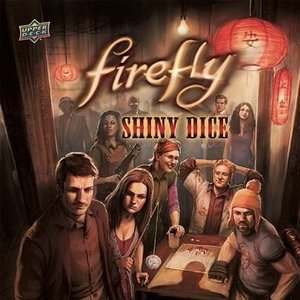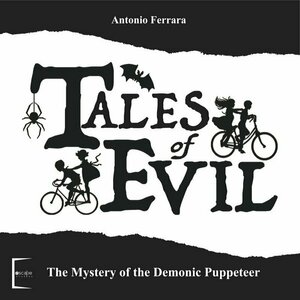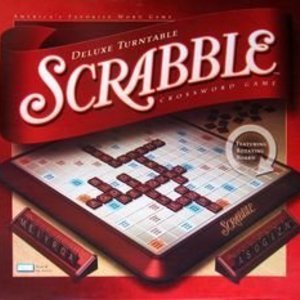Purple Phoenix Games (2266 KP) rated Firefly: Shiny Dice in Tabletop Games
Jun 12, 2019
I really like Firefly. So when Travis told me he had Firefly: Shiny Dice, and was looking to get rid of it, I jumped on the chance to get my hands on something Firefly! I’d never played the game and had never even heard of it either. Having played it now, though, I can see why Travis wanted to off-load it on someone else.
In Firefly: Shiny Dice, over the course of three rounds, players are rolling dice to assemble a crew, complete missions, and defeat bad guys. All of the main characters of the show are represented by different die faces, each with a special power. Use those powers to help defeat bad guys and earn VPs on your turn each round! The player at the end of the game with the most points is the winner. Firefly: Shiny Dice is played the same way, regardless of player count – in solo play, you are still trying to amass the most points possible over three rounds.
At it’s core, Firefly: Shiny Dice is a dice-rolling game. And that’s where the simplicity ends. This game is bogged down an ambiguously confusing rulebook, complicated turn steps, and just way too much text overall. When I first got this game, I was psyched to play. I sat down, opened up the rulebook, read through it at least 3 times, and then put the game away. I was so confused by what I had read, I couldn’t even bring myself to try it at first. There is a lot of ambiguity in the rulebook that caused a lot of confusion and frustration for me. For example, the brown dice are Outlaw characters and the white dice are Passenger characters, but the rulebook and player aids use “Crew Dice” most of the time – so are they all Crew Dice, or just the Outlaws since, in the show, those are the characters who actually are the crew on Serenity? Are Passengers considered Crew? The same ambiguity goes for Mission Cards – if you draw one that you cannot complete, is it just discarded? Then what’s the point of the Mission Card? How about if you draw one and don’t want to complete it? Are you required to complete it if you can? Or can you choose to ignore it to negate the Mission Keyword? I felt like after I read the rulebook, I actually had more questions than before I started.
Regarding turn order, there is just way too much going on for me. There are 4 steps each turn, and some steps have several ‘phases.’ First you roll your dice, and then depending on what you rolled maybe you can re-roll some, and then you have to check to see if you got any bonuses/penalties after your re-roll, but then you stop and draw a Mission Card and possibly resolve it (?), and now you go and deal 1 damage to a foe but only if the current Mission says ‘Shiny,’ and then the foe dice resolve their effects, and now you can use your dice and character powers to fight the foes, and then depending on how many dice you have left/the Mission Keyword from your card this turn, you can decide to push your luck and take another turn immediately or just end your turn now. Whew. There are just way too many unnecessary steps, in my opinion. All you should need to do is to roll/re-roll your dice, resolve foe effects, and fight the foes. The Missions and die bonuses/penalties feel extraneous to me, and result in clunky gameplay.
In theory, this should be a cool game. In reality, it’s just frustrating. To me it feels like every single small idea made it into the end-game, but they were not executed well enough to justify including them. This game is way too wordy and ambiguous to make sense, and even though I keep the rulebook on hand every time I play, I feel like it doesn’t really help me at all. I think a more pared down/edited version of this game could be a hit.
As a fan of Firefly, I want to like this game. I really do. But I don’t. I think it is too complicated and far too confusing for what it is supposed to be, which is a relatively light dice-rolling game. Firefly: Shiny Dice is not on my short-list of games to play, nor is it on my long-list (is that a thing?). It’s kind of just in my collection at this point, though I don’t know if it’ll stay here for long.
https://purplephoenixgames.wordpress.com/2019/01/28/solo-chronicles-firefly-shiny-dice/
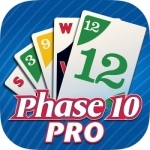
Phase 10 Pro - Play Your Friends!
Games and Entertainment
App
All new Phase 10, now with Multiplayer. The Phase 10 card game is now in the iTunes App Store! Play...
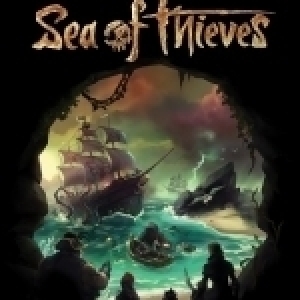
Sea of Thieves
Video Game Watch
Sea of Thieves is a Shared-World Adventure Game that immerses players in a rich, fantastical world...
Pirates Multiplayer Adventure

Overcooked 2
Video Game Watch
A chaotic co-op cooking game for 1-4 players in which you must serve a variety of recipes including...
Multiplayer Co-operative Chaotic
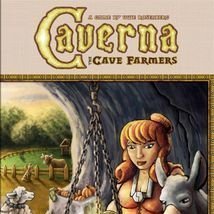
Caverna: The Cave Farmers
Tabletop Game
CLASSIFICATION EDIT Type Strategy Category Animals Economic Fantasy Farming Mechanisms ...
Boardgames UweGames

Small World 2
Entertainment and Games
App
This game is like risk, but Faster, Funnier, and more fun. "One of the most compelling games for...
BoardGames BoardGameApp GreatGames

Jaipur
Games
App
A Spiel des Jahres Recommended game, Jaipur is one of the most most well-loved 2-player tabletop...
Boardgames BoardgameApps Greatgames 2playerGames
Purple Phoenix Games (2266 KP) rated Tales of Evil in Tabletop Games
Oct 1, 2020
Tales of Evil is a cooperative, horror, storytelling, adventure game that uses a unique new “Fusion System” throughout the game. Players will be taking on personas of kids from the 1980s who belong to a club named “Pizza & Investigation.” I do not wish to reveal too much in this review, so I will be covering this as a Solo Chronicles using one character going through the introductory tutorial mission.
DISCLAIMER: We are using the Kickstarter Deluxe version of the game. We do have the expansions from the KS campaign, but will not be using those for this review. Also, we do not intend to cover every single rule included in the rule book, but will describe the overall game flow and major rule set so that our readers may get a sense of how the game plays. For more in depth rules, you may purchase a copy from the publisher directly or from your FLGS. -T
To setup, well, just follow the setup instructions in the rulebook. There’s too much for me to explain here. For one character playing the tutorial scenario, the game setup should look similar to what is pictured below. Maybe. The rulebook does not specifically state WHERE each item should be placed, so players will have ultimate freedom to setup items where they see fit to be most efficient for themselves.
Players in Tales of Evil will have no real “turn structure” as most games do, because all players will be adventuring together as a group. So characters will be moving as a group and never splitting the party (RPGers breathe a sigh of relief… maybe). However, as with many adventure games of this style, once players explore into new areas certain markers will placed on the board (Clue, Darkness, Mystery, Search, etc). These markers signify different actions that can be taken, or entrances to areas that are blocked or found, or something that could be traced from one area to another. The leader of the group for the time being is in possession of the Walkie-Talkie and will make all final decisions for the group after any discussion (for solo players, it is just a nice prop). Usually searching for items will result in a card draw and upon the card will be a test to pass using the stats on the player character mat to roll dice for successes. Of course, the other side of that are horrible losses as well.
Players will be traipsing through the area and reading passages from two actual books: the Story Book and the Event Book. Most of the action happens in the Story Book and it will guide players through the story and once choices are made or tests succeeded/failed, the book will instruct players what to do next and to which section to turn to further the story (a la Tales of the Arabian Nights). The game continues in this fashion until the story ends with victory or defeat.
Components. Why yes, that is a real spoon in the photo above. No, it does not come with the game. I will explain in a bit. The components in this game are great. Each character has their own mat for organization, action cards, equipment cards, and status cards that dictate the difficulty of the game and how the character degrades over time in the horror-filled mission. Some components are even glow-in-the-dark! A nice touch, but certainly unnecessary. I find everything to be wonderful quality, even the cards that are kind of polarizing on the KS comments are nice (people are complaining that they are not linen-finished, but I believe the publisher made the right call to make them matte finished if the linen obscured the look and art on them). Thumbs up for components from me.
I wanted to wait until my final thoughts to explain the whole “Fusion System” that is in play here. Tales of Evil uses the catchphrase, “You will get into the game and the game will get into you!” Now, I’m not sure exactly how this game is getting into me, but I’m certainly digging the game and this Fusion System. You see, some cards (in the tutorial, remember, so I’m not really giving much away here) will give players 60 seconds to grab a kitchen spoon for some benefit and a debilitation if they are unable to find one – hence the spoon in my photos. Another card relies on the character (and also then the player) removing their shoes. Still yet another deals with fire or people smoking in the vicinity. If there is fire nearby in real life, it affects the effects of the card drawn. It’s ingenious and I love every little bit of it! I can’t wait to see how the Fusion System will work in this game more and how it can be applied to other games in the future.
All in all I love everything about Tales of Evil. The setting is great, the Pizza & Investigation kids are awesome, and the game itself is incredibly engaging and makes you really think about the choices you make within. Perhaps the haunting feeling of doubting some choices is how the game gets into you, because I did find myself wondering what would have happened had I chosen a different course for some instances. I am very drawn to this game and I want to tackle all of the scenarios. Even solo! And another great thing about Tales of Evil is the fact that a player (or players) can join a game already in progress! So if I am exploring solo and my wife decides she wants to hop in, she just grabs a character mat, sets up the character, and dives right in with me. I LOVE games like that. So versatile.
While I should probably stop gushing at this point I just can’t. This game is so much fun and worth every penny spent on it. I implore you, if you are a fan of exploration adventure games in this vein you definitely need to snatch up a copy whenever you see one. And if you love it as much as I do let me know. We can swap adventure stories.
Oh did I mention the designer is even created a way for us normies to create our own scenarios and upload them to other Tales of Evil players? Yeah, I’m fascinated by that as well…

Splendor™
Games
App
** ONLINE MULTIPLAYER NOW AVAILABLE !!! ** The OFFICIAL digital adaptation of the best-selling...
BoardGames BoardgameApps GreatGames
